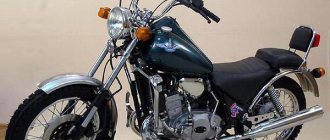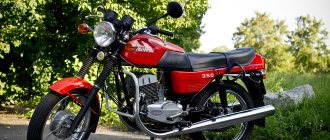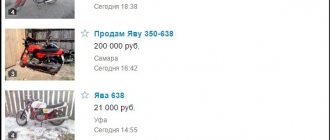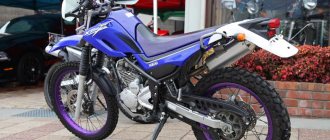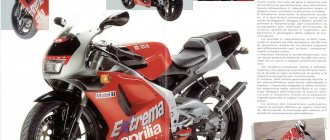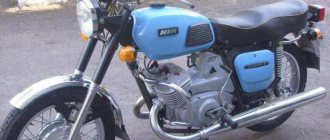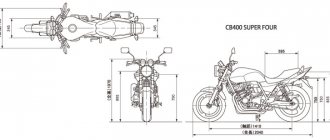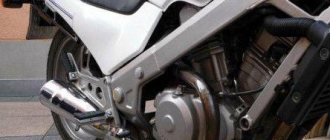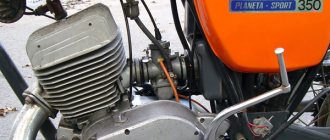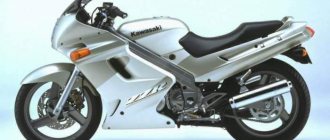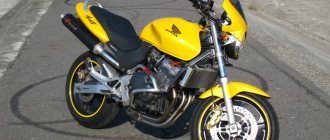Russian motorcyclesIZH motorcycles
Domestic motorcycle production was not particularly diverse.
The same manufacturer, which produces middle-class motorcycles, simply copied its models from generation to generation, only bothering to adjust the appearance and make minor changes to the technical part, but the concept of the motorcycle itself remained unchanged.
Only relatively recently did IZH designers decide to create something different from their main models.
This decision resulted in the appearance of such a model as the IZH Junker, whose factory marking is IZH 6.113-020-5.
Motorcycle appearance
This motorcycle turned out to be very interesting in appearance , but the technical part of the motorcycle has not changed much.
And yet, IZH Junker is probably one of the most remarkable models of the domestic motorcycle industry.
The designers tried to give their creation an American style , and they did it well.
If it were not for the “IZH” marking on the side covers, it would be difficult to recognize a domestically produced motorcycle in the Junker.
An advanced fork, a small headlight, a high bent handlebar, a low driver's seat and a teardrop-shaped tank give this bike a good resemblance to foreign choppers .
The designers and engineers really did a good job on the appearance. They had to slightly change the geometry of the frame to ensure a low landing, but the frame design itself is the same - tubular, with welded seams.
The tank on the IZH Junker actually consists of two small halves, between which they installed an instrument panel consisting of a speedometer and a window for warning lights.
But the design of the speedometer and windows was not changed, although something original could have been invented. These same tanks also cover the electrical wiring, which is traditionally attached to the frame.
The motorcycle received a stepped seat, consisting of two parts ; the rear seat also has a backrest, which is already included in the base with the motorcycle. The rear light was placed on this backrest.
In the modern world, children's ATVs running on gasoline are very popular; descriptions and characteristics of some models can be found here.
A sports model of an ATV for the entertainment and development of the younger generation: https://themoto.net/atv/kvadrotsiklyi-dlya-detey/ryis-125-sport.html
Specifications
The power plant is a two-cylinder, in-line, water-cooled, but its technical characteristics do not differ from conventional IZH models.
But this can also have a positive effect; repairs to the Junker will not be expensive .
In front of the cylinders, a cooling radiator is mounted on the frame, which is protected from damage by safety bars on the sides.
Engineers have not yet come up with a starter for a power plant of this design, so the power plant is started by a foot kick starter located on the left side. The exhaust system is double, one pipe for each cylinder, with outlets on both sides of the motorcycle.
Engine lubrication is still the same, together with fuel.
The gearbox and drive are standard Izhevsk ones. Gearbox is a 4-speed manual equipped with a semi-automatic clutch. The drive is chain, located on the right side.
For ease of entry, the driver's footrests were moved forward , and to make it possible to conveniently control the gearbox and rear brakes, their pedals were lengthened.
The front of the Junker is already equipped with a hydraulically driven disc brake, but the rear has the same mechanically driven drum brakes.
The front suspension of the Junker consists of a hydropneumatic telescopic fork, which has a good ride . But the rear suspension is the old “Izhevsk” pendulum with two shock absorbers, but they are already positioned at an angle.
Well, IZH Junker looks fresh and unusual, like a domestic motorcycle.
And although it does not shine with technical indicators, the power plant together with the gearbox has long been time-tested and are reliable , and if it breaks down, repairing it will not be a problem due to the simplicity of the design and the general availability of spare parts, since IZH Junker has unified many design elements with motorcycles of the IZH family.
The technical characteristics of this motorcycle are summarized in the table:
| Technical characteristics Characteristics of IZH Junker | ||
| Parameter | Unit change | Index |
| Length | mm | 2400 |
| Width | mm | 900 |
| Height | mm | 1520 |
| Wheelbase | mm | 1600 |
| Ground clearance | mm | 175 |
| Power point | type | 2-cylinder, in-line, |
| Working volume | cube cm. | 347,6 |
| Power | hp | 24,5 |
| S-ma cooling | type | liquid |
| Start date | type | kick starter |
| Transmission | type | mech, 4-speed, |
| Drive unit | type | Chain |
| Speed max. | km/h | 115 |
| Average consumption | l/100 km | 5,7 |
| Volume of the tank | l | 2x7.5 |
Good day to all. I’ve been here for quite a long time, there were some posts, but I never got around to writing about how this beast appeared. There are a lot of posts about the appearance, so let there be one more.
Let's get started. Please under cat. There will be few photos, and those are from VK, so I apologize for the blocks and small number, I went after the motorcycle without a camera.
The whole story with Junker began around May 2015, when it was decided to replace the Chinese sub-cruiser Corvette with 50 (in documents) cubes with more serious equipment.
I already knew from the beginning that I would sit exclusively on a cruiser (a chopper, in my understanding, is a slightly different motorcycle). The budget was quite modest for 2015 - something up to 100 kilorubles. The original goal - Irbis Garpia - was no longer needed by the time the final decision was made, because the price for it was raised to 130k in my city. The Japanese were attractive, but alas, it was hard for me to pull it off. I’ll buy something, but the initial service might not work out, and the lower price category implies a large number of “Franken-motos”. There’s no way I’m going to get into loans, that’s enough, I won’t get into it on principle and I’ll buy the money with my own money.
I had to smoke forums and advertisements in a long puff until I remembered Junker. I registered on the forum and began to study this beast. Somewhere in March, I wrote about this motorcycle to one of the Junker drivers for advice (it was thanks to him that I decided on the Junker, for which THANK YOU very much), and so the search for advertisements began. In my city there are about ten such motorcycles and there was only one for sale. In the center of one of the districts of the region. After a short phone call, it was decided to take a look at this miracle.
Actually, the culprit of the whole story is now my faithful friend, IZH-6-113 Junker. 2001 release. Serial number - 46.
August 10, 2015. Monday. The first day.
I am calling the seller to look at the unit for sale. After which I called my friend Yura (a deep bow for what happened next and for help with maintenance) with the goal of going to see the unit. At 6 pm we load up from my work, select a seller, fill up with gas - and drive one and a half hundred kilometers away to look at the motorcycle.
We arrive around 10 pm, the seller takes the documents and drives to the garage. In the garage we are met by HE - Juncker, covered with the annual dust. We fill up with gasoline and water and the motorcycle starts the first time. The sound is pleasant. The seller drove it a little, after which we drove it a little. So, it’s on the move, the mileage is somewhere up to 15-20 thousand, since there is no speedometer cable and its specific mileage is a mystery (the figure on the odometer is frozen at 8-something thousand).
Now the shoals have surfaced: no front brakes, no side dams, the motorcycle has been successfully attached to each side, possibly more than once, welded legs and links, in general the motorcycle has been battered by life. In principle, I was happy with everything about it, since, except for the brakes, nothing affected the driving performance. Yura looked at its technical condition and was very surprised that there was nothing knocking, farting or ringing. We walked away and whispered, since I was happy with the motorcycle, and the bidding with the seller began. When the bidding reached a dead end, Yura refreshed them and we agreed on a fairly compromise price of 30 kilo rubles. The time is 23 pm, or night.
We sign the documents and start back. The former owner drives to a gas station, fills up the motorcycle there, and that’s it. Now I load onto it and set off on the way back. It was a little scary to ride this motorcycle, since it was unfamiliar to me and, in fact, it was my first “full-fledged” motorcycle. The feelings are indescribable. At night, without license plates and documents, passing the traffic police post - it was scary, but there was zero reaction to me. About 60 kilometers after the post I stop and hand over the bike to the former owner. So to speak, so that he could say goodbye to him. He cheerfully turns the Junker at about 130 according to the Audi speedometer.
About 2/3 of the way I change to Junker and notice that the headlights are getting dimmer and dimmer, and the ride is getting sadder and sadder. I stop, change hands with the owner and drive to the nearest gas station. Under the streetlights at one o'clock in the morning we find out the reason - the BPV has died. The city is 50 kilometers away. The motorcycle is still capable of traveling 10-15 kilometers. Yura calls one of his relatives in one of the nearby villages - and we head there. You have to return about 10 kilometers and the same amount to the side. All this must be done without headlights so that the motorcycle can travel the maximum distance.
We remembered vicious women and arctic foxes, but we don’t have to choose - the motorcycle won’t be there on its own. Yura is in the Audi in front, I am with him, the owner is behind us. No headlight. We get to the turn and turn onto the dirt road. About two in the morning, stars, night and a motorcycle ready to finally die. Romance. We drive 8-10 kilometers from the turn and that’s it. Juncker decided that he had had enough and stalled. Tightly. In field. We stood there, looked at the stars and decided to drag the motorcycle to the village on a leash. They hooked the Junker, put the owner in prison, and off they went.
We successfully reached the relatives, but we couldn’t reach them, so the motorcycle was driven behind the gate of the house and left until the next day. We all loaded into the car and headed home. I was home at three in the morning.
August 11, 2015. Day two.
I called Yura, after work he picked me up with my colleague, whose sister is in the house where we left the motorcycle. We get there without incident. On the spot, in 5 minutes we change the dead batteries and the BPV (two of each were captured), after which we are called to the table. An excellent rustic stew and tea with honey were waiting for us at the table. They showed me a tomato the size of a child’s head and loaded the car with zucchini and vegetables. You can go home too.
I start up and the Junker engine rumbles contentedly. It's 10 pm - we're leaving. While we are driving to the highway, I manage to get scared about ten times and almost run over about three dozen blackbirds, which, with the true spirit of a kamikaze, threw themselves under the wheels of the motorcycle.
The exit to the highway is a neat 60-70 kilometers. The cadet rushes like a cruiser - he is not even blown away by the flow from the trucks flying towards him (the Corvette was simply rearranged by half a half mile from them). Somewhere on the approach to the city, I begin to feel completely stiff and chatter my teeth, despite the warm ammunition of a windproof jacket and two sweaters, plus warm winter pants. At the entrance to the city, I fly past the required turn, but, pushing off on foot along the side of the road, I taxi into it.
At the roundabout we say goodbye to Yura and head home. I enjoy the city at night and confidently move towards home. About 2-3 kilometers from home the motorcycle stalls. Tightly. The reason is that the gas in the tank has run out. And there are two tanks. There is gasoline in the second tank, but it is not flowing. I have no desire to carry a motorcycle on myself. The dog rummaged through different taps - in the same positions, one was open and the other was closed. I swear loudly, but to myself and to myself. I open it, pump it in and start it up. Great. Ten minutes later I was already home. The time is two in the morning. Happy to finally have the motorcycle fitted, I fall asleep.
That, in fact, is the whole story with its purchase. He is now sleeping in the garage, waiting for the new season and new goodies.
Estimated cost
Production of IZH Junker has stopped , and it will no longer be possible to purchase a new motorcycle.
But for those who still want to own a motorcycle that is so non-trivial for our motorcycle industry, help can be provided by the secondary market, where it is still found, and the cost of this unit is not at all high and ranges from 30 to 90 thousand rubles.
At one time, this motorcycle was awarded the State Quality Mark - IZH Jupiter 3, the technical characteristics of which ensured reliability.
The design of this IZH motorcycle is made in a classic style and differs little from the appearance of its contemporaries.
Power point
The power unit on the Junker is the same as on all the latest models of the IZH concern. This is a water-cooled Yu6 engine (inherited from Jupiter). What can we say about an engine that is already twenty years out of date! But in the absence of anything else, all that remains is to list the advantages and disadvantages. Yu6 is a two-stroke two-cylinder internal combustion engine. Its working volume is only 347 cubic centimeters, and maximum power is measured at 24 horsepower. The operating frequency (according to the technical data sheet) is approximately 6000 rpm, but in fact this value is overestimated. The actual range is 5000 rpm.
U6 is suitable for any gasoline with an octane rating of at least 80. The ideal “food” is AI-92. There is no need to pay attention to the quality of the fuel. The two-stroke engine is not susceptible to bad food. But it’s still better not to take risks and refuel your favorite bike at proven stations.
The consumption of the same fuel per hundred kilometers is relatively small. Within the city this is 7 liters, on the highway at a speed of 90 km/h this number decreases to 5.5 liters, and on a flat road at a speed of 60 km/h it becomes completely ridiculous - only 4 liters per 100 kilometers. Two tanks hold 15 liters, respectively, at average costs, the motorcycle can last 300 kilometers without refueling. Also, do not forget that the Yu6 is a two-stroke engine, so you should always add 2T oil to the gas tank after each refueling. After all, the lubricant comes with the fuel.
Photo gallery
Izh Junker is a recreational motorcycle that you have most likely encountered more than once, but you would not even suspect that this motorcycle came out of the assembly line of the Izhevsk plant. It’s not for nothing that it is considered one of the most beautiful models of domestic production. Let's look at it in our selection.
The highlight of the model
A striking feature that distinguishes the Junker from other representatives of light transport is its appearance. It was the innovation on the part of the designers that gave IZH unheard-of fame.
For the first time, a recreational motorcycle “for people” could see the light of day.
IZH "Junker" is a chopper - a type of motorcycle distinguished by an abundance of chrome parts, a high handlebar and an upright seating position. “Junker” immediately became a road classic, and its distinctive features were remembered by many. You just can't help but notice the shiny teardrop-shaped fuel tank. After a short search, you can also see the instrument panel, smoothly integrated into the upper part. The structure of the saddle is also pleasing. The two-stage seat, made for a comfortable seating position for the driver, ends with a backrest.
This small detail allows you to carry another person in the back without compromising safety. Also, importantly, the foot pedals are moved forward. It may sound like a small thing, but in fact this innovation made it possible to straighten the legs when landing. Previously, they had to be tucked under oneself, which brought discomfort and fatigue to the legs during long trips and more. The high, raised steering wheel looks impressive. But this is not the simple boast of a daredevil designer. In fact, this shape of the steering wheel contributes to the convenient placement of instruments and easier control.
IZH "Junker" is stunning even today with its appearance. Few things can compare with it in beauty. Therefore, this motorcycle has remained relevant and, most importantly, desirable for more than fifteen years.
Video
Driving the Izh Junker motorcycle is pleasant because of its flexibility and excellent dynamics. You shouldn’t expect him to be a champion in races, but it won’t be too difficult for him to get around a difficult turn almost silently and go smoothly along problematic roads.
In this video you can take a closer look at this beautiful motorcycle, enjoy the sound of the engine and see it in action.
Did you like the article? Tell your friends!
Comments (1)
- mizrob:
08/29/2016 at 09:35Class
Answer
